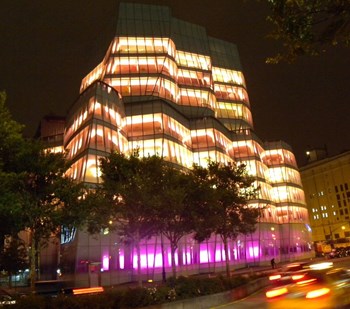
For years, Chelsea was a highly industrial fringe neighborhood, a commercial center on the west side of Manhattan filled with stables, railyards and rowhouses, but today it’s a popular place for restaurants, nightclubs, retail shopping and avant-garde art, fashion and furnishings.
The district's boundaries are roughly 14th Street to the south, 30th Street to the north, the western boundary of the Ladies' Mile Historic District between Sixth and Seventh Avenues to the east, and the Hudson River and West Street to the west. Adjacent to Chelsea on the north is Hell's Kitchen, renamed by brokers today as "Clinton," to the northeast is the Garment District, to the east are NoMad and the Flatiron District, to the southwest is the Meatpacking District and to the southeast is the West Village.
Named after a London Manorhouse
Historically, Chelsea’s name derives from the estate and Federal-style house of retired British Major Thomas Clarke, who obtained the property when he purchased the farm of Jacob Somerindyck in August 1750. The land was bounded by what would become 21st and 24th Streets, from the Hudson River to Eighth Avenue.
Clarke chose the name "Chelsea" after the manor of Chelsea, London, home to Sir Thomas More. Clarke passed the estate on to his daughter, Charity, who, with her husband Benjamin Moore, added land on the south of the estate extending it to 19th Street. The house was the birthplace of their son, Clement Clarke Moore, who in turn inherited the property. Moore is generally credited with writing the poem "A Visit From St. Nicholas" and penned the first Greek and Hebrew lexicons printed in the United States.
In 1827, Moore turned over some of his land to the Episcopal Diocese of New York for the General Theological Seminary, which built its brownstone Gothic, tree-shaded campus south of the manor house. Around this same time, Moore began developing Chelsea with the help of James N. Wells, dividing it up into lots along Ninth Avenue and selling the land to wealthy New Yorkers. Covenants in the deeds of sale specified what could be built on the land—stables, manufacturing and commercial uses were expressly forbidden. How the buildings were constructed was also spelled out.
The new neighborhood expanded over the next three decades past the boundaries of Clarke’s original estate. However, an industrial zone soon developed along the Hudson. In 1847, the Hudson River Railroad laid its freight tracks up a right-of-way between Tenth and Eleventh Avenues, separating Chelsea from the Hudson River waterfront. The industrialization of western Chelsea followed, and brought immigrant populations from many countries to work in the nearby factories, including a large number of Irish immigrants.
In addition to the piers, warehouses and factories, the industrial area west of Tenth Avenue also included lumberyards, breweries and tenements to house the workers.
The area soon became a hotbed of union and political activity. Festering ethnic tensions came to a head during a riot between Irish Catholics and Irish Protestants on July 12, 1871. Sixty-seven people died in the clash, which took place around 24th Street and Eighth Avenue. The social problems of the area's workers provoked John Lovejoy Elliot to form the Hudson Guild in 1897, one of the first settlement houses—private organizations designed to provide social services.
Apartment Houses and Moving Pictures
The neighborhood is primarily residential, with a mix of tenements, apartment blocks, city housing projects, townhouses and renovated rowhouses, and its many retail businesses reflect the ethnic and social diversity of the population. The western part of Chelsea has become a center of the New York art world, with many art galleries located in both new buildings and rehabilitated warehouses.
Many large apartment complexes comprise the majority of the housing stock in Chelsea. One such development, London Terrace, consisting of 1,670 units, was one of the world's largest apartment blocks when it opened in 1930, with a swimming pool, solarium, gymnasium, and doormen dressed as London bobbies. The complex takes up the full block between Ninth and Tenth Avenues and 23rd and 24th Streets. Designed by Farrar and Watmough, it takes its name from the fashionable mid-19th century cottages which were once located there.
Other major housing developments in the area are Penn South, a 1962 Mitchell-Lama cooperative housing development sponsored by the International Ladies Garment Workers' Union, and the New York City Housing Authority-built and operated Fulton Houses and Chelsea-Elliot Houses. Penn South, which contains 2,820 apartments, covers six city blocks between 8th and 9th Avenue and runs between 23rd and 29th Street.
By 1869, a theatre district had formed in the area and soon West 23rd Street was the center of American theater, led by Pike's Opera House (1868, demolished 1960), on the northwest corner of Eighth Avenue. Chelsea was also an early center for the motion picture industry before World War I. Some of Mary Pickford's first pictures were made on the top floors of an armory building at 221 West 26th Street, while other studios were located on 23rd and 21st Streets.
The Hotel Chelsea
One of the city’s first cooperative apartment buildings and Chelsea’s most famous landmark was the Hotel Chelsea at 222 West 23rd Street between Seventh and Eighth Avenues, a 12-story, red-brick, Victorian Gothic-style structure with wonderful balconies that were made by J. B. and J. M. Cornell. It was built in 1884 and designed by Hubert, Pirsson & Co. Among its many illustrious restaurants over the years have been writers Mark Twain, O. Henry, Thomas Wolfe, Dylan Thomas, Arthur Miller, Tennessee Williams and Brendan Behan, artists John Sloan and Jackson Pollack, composer Virgil Thompson and actress Sarah Bernhardt. Andy Warhol’s 1966 movie, "The Chelsea Girls," was shot in the building, which was converted to a hotel. The hotel attracted attention as the place where Dylan Thomas had been staying when he died in 1953 and for the 1978 slaying of Nancy Spungen for which musician Sid Vicious was accused. Some of the other popular venues in the neighborhood include The Chelsea Market and the year-round recreational facility, Chelsea Piers.
The Development of the High Line
Chelsea is divided between Manhattan Community Board 4 and Manhattan Community Board 5. It contains the Chelsea Historic District and its extension, designated by the New York City Landmarks Preservation Commission in 1970 and 1981, respectively, and added to the National Register of Historic Places in 1977. It was expanded in 1982 to include contiguous blocks containing particularly significant examples of period architecture.
The newest Chelsea news—and some of the hottest condos for sale—are on the Far West Side, where the south section of the High Line, an elevated park that’s been created from an abandoned railroad track, is now open. The modern development will offer walking and biking paths and a green respite from the concrete jungle. Some of the new developments include The Modern 23 on West 23rd Street, the Chelsea Atelier, the HighLine 519 and HL23 on West 23rd Street. The Art Deco Verizon building entrance on 17th Street, built in the early 1930s, is also under consideration for conversion to condos.
The median sales price for homes in Chelsea for Dec 10 to Feb 11 was $1,450,000. This represents a decline of 3.5%, or $52,500, compared to the prior quarter and an increase of 20.3% compared to the prior year. Sales prices have appreciated 92.1% over the last 5 years in Chelsea, New York. The median sales price of $1,450,000 for Chelsea is 38.10% higher than the median sales price for New York, N.Y. Prices range from about $600,000 for a one-bedroom condo to upwards of $3.8 million for a three-bedroom loft.
According to Trulia.com, the average listing price for homes in Chelsea was $1,778,576 for the week ending Mar 16, which represents an increase of 0.2%, or $4,259 compared to the prior week and a decline of 0.5%, or $8,383, compared to the week ending Feb 23. Average price per square foot for homes in Chelsea was $1,304 in the most recent quarter, which is 8.22% higher than the average price per square foot for homes in New York.
Debra A. Estock is managing editor of The Cooperator.






Leave a Comment